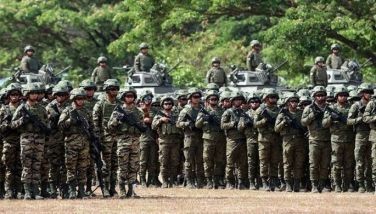New tech can pinpoint location of schools of fish
August 7, 2005 | 12:00am
A technology that can locate schools of fish through the color of the ocean’s surface continues to excite the interest of the country’s fisheries sector.
Among those interested in the technology are fishing companies.
The Department of Agriculture-Bureau of Fisheries and Aquatic Resources (DA-BFAR) has also been using data generated by the research project titled "Ocean color for sustainable fisheries."
Also drawn by the three-year study’s results is the National Mapping for Resources Information Agency (NAMRIA) under the Department of Environment and Natural Resources (DENR).
The research was conducted by the UP Marine Science Institute (UP-MSI) and funded by the DA-Bureau of Agricultural Research (BAR). The researchers were Drs. Laura David (leader), Cesar Villanoy, Wilfredo Licuanan, Nemesio Montaño, Vincent Hilomen Miguel Fortes, Ma. Javee Udarbee-Walker, and Liana McManus.
Collaborating agencies were UP Visayas-Institute of Marine Fisheries, UP Los Baños, DA-BAR, Department of Science and Technology-Philippine Council for Aquatic and Marine Research and Development (DOST-PCAMRD), Philippine commercial fishing industries, United States National Aeronautics and Space Agency (NASA), US National Oceanographic Atmospheric Administration (NOAA), OrbImage, and Development Alternatives Inc.
The UP-MSI team said that the scientific process can identify areas with abundant plankton, a mass of tiny plants and animals floating in the sea or in lakes, usually near the surface, and eaten by fish and other aquatic animals.
"Areas of planktonic production are potential fishing areas," it stressed.
The scientists explained that ocean color date are related to the presence of particulates or substances on the water’s surface, especially the presence of photosynthetic phytoplanktons (tiny plants) that contain chlorophyll (the green matter of plants).
They added that the oceanographic features can be mapped in near real time basis with the use of satellite technology. This capability, coupled with the knowledge of oceangraphic conditions affecting fisheries population and historical catch data, can lead to forecasting of fish populations and their movements. – Rudy A. Fernandez
Among those interested in the technology are fishing companies.
The Department of Agriculture-Bureau of Fisheries and Aquatic Resources (DA-BFAR) has also been using data generated by the research project titled "Ocean color for sustainable fisheries."
Also drawn by the three-year study’s results is the National Mapping for Resources Information Agency (NAMRIA) under the Department of Environment and Natural Resources (DENR).
The research was conducted by the UP Marine Science Institute (UP-MSI) and funded by the DA-Bureau of Agricultural Research (BAR). The researchers were Drs. Laura David (leader), Cesar Villanoy, Wilfredo Licuanan, Nemesio Montaño, Vincent Hilomen Miguel Fortes, Ma. Javee Udarbee-Walker, and Liana McManus.
Collaborating agencies were UP Visayas-Institute of Marine Fisheries, UP Los Baños, DA-BAR, Department of Science and Technology-Philippine Council for Aquatic and Marine Research and Development (DOST-PCAMRD), Philippine commercial fishing industries, United States National Aeronautics and Space Agency (NASA), US National Oceanographic Atmospheric Administration (NOAA), OrbImage, and Development Alternatives Inc.
The UP-MSI team said that the scientific process can identify areas with abundant plankton, a mass of tiny plants and animals floating in the sea or in lakes, usually near the surface, and eaten by fish and other aquatic animals.
"Areas of planktonic production are potential fishing areas," it stressed.
The scientists explained that ocean color date are related to the presence of particulates or substances on the water’s surface, especially the presence of photosynthetic phytoplanktons (tiny plants) that contain chlorophyll (the green matter of plants).
They added that the oceanographic features can be mapped in near real time basis with the use of satellite technology. This capability, coupled with the knowledge of oceangraphic conditions affecting fisheries population and historical catch data, can lead to forecasting of fish populations and their movements. – Rudy A. Fernandez
BrandSpace Articles
<
>
- Latest
Latest
Latest
April 10, 2024 - 5:12pm
By Ian Laqui | April 10, 2024 - 5:12pm
March 4, 2024 - 3:32pm
By Ian Laqui | March 4, 2024 - 3:32pm
March 4, 2024 - 2:12pm
By Kristine Daguno-Bersamina | March 4, 2024 - 2:12pm
February 17, 2024 - 2:31pm
February 17, 2024 - 2:31pm
February 13, 2024 - 7:24pm
By Gaea Katreena Cabico | February 13, 2024 - 7:24pm
Recommended




























